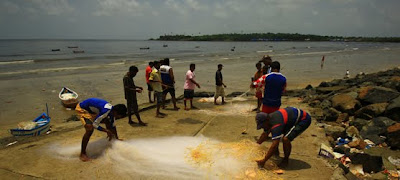I first came to Shroff building for Anantchaturdashi in 2013. Shroff building stands at a unique confluence of roads. The Lalbaug flyover sweeps majestically past it. The ganeshas appear as if by magic from under the flyover and as they pass Shroff building they are showered with petals, flowers and vermillion powder from a contraption in the sky.
The Ganesha festival symbolises man's life on earth. Ganesha begins his own short life as a germ of an idea in a murtikar's brain. The murti is then 'created', brought home, made alive by pooja and after a short stay the 'body' is immersed in the sea. Thus symbolising our short stay on earth.
Shroff building does not have it's own Ganapathy but celebrates all the Ganapathys on their way to the sea by this unique shower of flowers as if from the heavens.
On the day of visarjan the roads are thrown open to the madding crowd which accompanies each Ganesha. The photographer has to negotiate with and through this crowd to get a good vantage point from where he/she can click pictures of this chaotic order and it's progenitor - the Ganesha.
Humanity had the misfortune of inventing guns first and the camera second. Much beauty would have been preserved had it been the other way around. Because guns were invented first, photography inherited all the jargon of shooting without the associated violence.
As the great Ansel Adams said, “You don’t take a photograph, you make it.” It took me four years to seek out and make this photo at the heart of Lalbaug.
The first step in making a picture is selecting the perfect vantage point. The Merriam-Webster dictionary defines a vantage point as a place or position affording a good view of something.
At Shroff building the perfect vantage point for clicking a picture of the pushpavrishti is NOT Shroff building. It is instead a point directly across the road in front of it, about ten meters ahead of it, towards Chinchpokli bridge. My first two years were spent in negotiating the crowd and searching for the perfect vantage point.
The second step in clicking a picture is having the perfect gear for the vision in your mind. For two years i had been clicking the same spectacle at Lalbaug and ennui had set in. The time had come, I thought, to drill down into the spectacle. What drew lakhs of devotees year after year to the same place to witness the same pushpavrishti?
After 9 days of feteing and feasting the Lord the devotees gather to gift Him a suitable sendoff - a shower of coloured, scented petals drifting down gossamer like on his head and soothingly sliding down His bare shoulders. Yes, this is not a shower of whole flowers, but a shower of individual petals, lovingly teased out beforehand. This was then the atom in the universe of Lalbaug, the petal in the crowd. I wanted to capture this individual petal floating down onto the Lord and sliding down His shoulders.
Robert Capa once said, “If your pictures aren’t good enough, you’re not close enough.” To capture an individual petal i either had to come closer to the Lord, an impossibility in the milling maddening crowd, or click Him from a safer distance zooming in with a telephoto lens. I chose the latter so as not to be shaken by the crowd during the shoot.
By the third year i had assembled my perfect gear as per my modest serious hobbyist's budget and was all set to click when the heavens opened up and it rained all through the day!
The third step in clicking a picture is to balance your aperture, shutter speed and ISO settings to get the picture as close to the vision in your mind as possible, while ensuring the correct exposure.
Anantchaturdashi 2017 was a bright sunny day and i set out with high hopes of clicking a fastest shutter speed picture. In order to freeze a falling petal or flower one needs a very fast shutter speed which in turn needs very bright ambient light.
To get individual petals to be seen it was necessary to zoom in at 600mm. Zooming in at 600mm causes the depth of field to become wafer thin. So one has to decrease the aperture to increase the depth of field.
If the ambient light is low one can achieve a fast shutter speed by jacking up the ISO, but this causes noise in the picture and hence is not desirable. So the ISO was jacked up to maximum permissible level of 1600 as after that the noise would have come through.
Morever since the Ganeshas are about 5-6 feet broad one has to decrease the aperture to achieve a sufficient depth of field to get every petal pin sharp at that zoomed in focal length. Decreasing the aperture means decreasing the amount of light let into the camera. So having very bright ambient light helps. After experimentation I settled on an aperture of F/10.
The fourth step was to frame the picture according to the vision in mind. Since i had decided to use a zoom lens due to budgetary restrictions and wanted to capture the individual petal the decision was easy.
I decided to zoom in at maximum focal length to get a head and shoulders with trunk, portrait of the Lord. To capture the falling petals I kept the camera on a high speed continuous shooting mode. Zooming in at max allowed me to exclude all other distractions and focus only on the Lord and the petals.
That is how I captured the petal in the crowd, the atom of that Lalbag universe, as it floated down onto the Lord.





